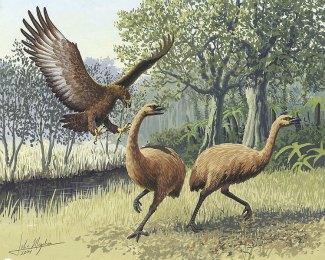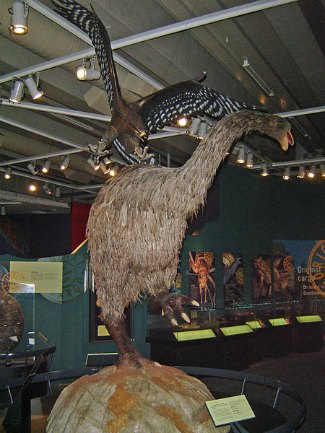Haast's Eagle [extinct] - Harpagornis moorei
By John Megahan, CC-BY-2.5, via Wikimedia Commons
Family: Accipitridae
Genus: Harpagornis
Species: H. moorei
Haast’s Eagles were the largest and most powerful eagles known to exist on Earth. Bones have been found on the South Island of New Zealand, and the youngest may be only 500 years old, indicating that humans existed alongside Haast’s Eagles. These raptors went extinct around 1400 CE after Polynesian colonization; it was soon after the moas diet out, which were their main source of food. Maori are thought to have killed Haast’s Eagles, since tools made from the bird’s bones have been discovered.
Only three complete skeletons have been found, which currently reside at the Otago Museum in Dunedin and the National Museum of Wellington in New Zealand, and the National History Museum in London, England.
Description:
Haast’s Eagles had a narrow skull and long beak. Their wings were short, built for flapping flight and maneuvering through dense forest. They were able to put much more force into their feet than other raptors, and could crush the pelvis of a moa. Their talons were up to 7 cm long and 8.5 cm in circumference.
Haast’s Eagles could live to be up to 20 years old.
Size:
Length: 1.4 m
Wingspan: 2.6-3 m
Weight: Male: 9-12 kg. Female: 10-15 kg.
Habitat and Distribution:
They lived in forest, scrubland, and grassland. Pairs occupied territories up to several hundred square kilometers, and it is unlikely there were ever more than 2,000 breeding individuals at one time.
By DO'Neil, GFDL, via Wikimedia Commons
Diet and Hunting:
They ate large animals from 1-200 kg, including flightless birds such as moas, which usually died of shock or blood loss after being attacked. They also ate carrion.
Based on remaining skeletons, it is thought they hunted in forests by perching on a branch and diving to catch prey at speeds of up to 80 km per hour. There were no other major predators to compete with at the time, and they are the only eagles known to have been the top predator of an entire ecosystem.
Taxonomy:
DNA evidence has shown that Harpagornis moorei may have evolved from Aquila morphnoides (Little Eagle)—the smallest eagles in the world—and Aquila pennata (Booted Eagle). If so, the species increased in weight by 10-15 times, which would be the fastest evolutionary increase of any known vertebrate.
Haast’s Eagles are named after Dr. Julius von Haast, director of the Canterbury Museum, who discovered them around 1870. Their scientific name Harpagornis moorei comes from the name of the owner of the site where many bird bones were found, George Moore.
Other Names:
New Zealand Eagle, Haasts Arend (Dutch), Aigle géant (French), Haastadler (German), Te Pouakai, Te Hokioi (Maori).
Heraldry:
Haast’s Eagles were seen by the Maori as the ancestor of ceremonial kites, and thought to carry off and eat people. They were also depicted in rock drawings.
References:
http://collections.tepapa.govt.nz/theme.aspx?irn=1360
http://www.independent.co.uk/environment/nature/maori-legend-of-maneating-bird-is-true-1786867.html
http://www.nzbirds.com/birds/haasteagle.html
http://www.palaeocritti.com/by-group/aves/neornithes/harpagornis-moorei
http://www.petermaas.nl/extinct/speciesinfo/haastseagle.htm

